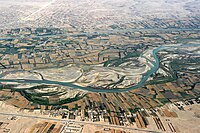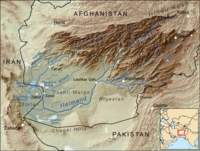Loading AI tools
Major river in Afghanistan From Wikipedia, the free encyclopedia
The Helmand river (Pashto/Dari: هیرمند / هلمند; Ancient Greek: Ἐτύμανδρος, Etýmandros; Latin: Erymandrus), also spelled Helmend, or Helmund, Hirmand, is the longest river in Afghanistan and the primary watershed for the endorheic Sistan Basin.[1] It originates in the Sanglakh Range of the Hindu Kush mountains in the northeastern part of Maidan Wardak Province, where it is separated from the watershed of the Kabul River by the Unai Pass. The Helmand feeds into the Hamun Lake on the border of Afghanistan and Iran.
| Helmand | |
|---|---|
 Helmand and Boghra Canal beyond it | |
 Map of the Helmand drainage basin | |
| Location | |
| Countries | Afghanistan and Iran |
| Physical characteristics | |
| Source | |
| • location | Hindu Kush mountains |
| Mouth | |
• location | Hamun Lake |
| Length | 1,150 km (710 mi) |
| Basin size | Sistan Basin |
| Basin features | |
| Tributaries | |
| • left | Arghandab River |
| • right | Khash River Chagay River |
 | |
The name comes from the Avestan Haētumant, literally "dammed, having a dam", which referred to the Helmand River and the irrigated areas around it.[2] The word Haetumant is cognate with Sanskrit Setumatī meaning "one which has a dam."[3][4]

The Helmand stretches for 1,150 km (710 mi). It rises in the northeastern part of Maidan Wardak Province in the Hindu Kush mountains, about 40 km[5] west of Kabul (34°34′N 68°33′E), flowing southwestward through Daykundi Province and Uruzgan Province. After passing through the city of Lashkargah in Helmand Province, it enters the desert of Dasht-e Margo, and then flows to the Sistan marshes and the Hamun-i-Helmand lake region around Zabol at the Afghan-Iranian border (31°9′N 61°33′E). A few smaller rivers such as Tarnak and Arghandab flow into Helmand.[6]
This river, managed by the Helmand and Arghandab Valley Authority, is used extensively for irrigation, although a buildup of mineral salts has decreased its usefulness in watering crops. For much of its length, the Helmand is free of salt.[7] Its waters are essential for farmers in Afghanistan, but it feeds into the Hamun Lake and is also important to farmers in Iran's southeastern Sistan and Baluchistan province.
A number of hydroelectric dams have created artificial reservoirs on some of the Afghanistan's rivers including the Kajaki Dam on the Helmand River. The chief tributary of the Helmand river, the Arghandab River (confluence at 31°27′N 64°23′E), also has a major dam, north of Kandahar.
The Helmand valley region is mentioned by name in the Avesta (Fargard 1:13) as the Aryan land of Haetumant, one of the early centres of the Zoroastrian faith in areas that are now Afghanistan. However, by the late first millennium BC and early first millennium AD, the preponderance of communities of Hindus and Buddhists in the Helmand and Kabul valleys led to Parthians referring to it as India.[8][9][10][11] From 1758 to 1842, the Helmand formed the northern borders of the Brahui Khanate of Kalat.[12]
Seamless Wikipedia browsing. On steroids.
Every time you click a link to Wikipedia, Wiktionary or Wikiquote in your browser's search results, it will show the modern Wikiwand interface.
Wikiwand extension is a five stars, simple, with minimum permission required to keep your browsing private, safe and transparent.